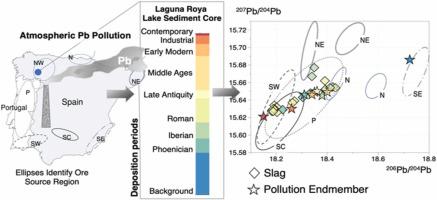Anthropocene ( IF 3.6 ) Pub Date : 2023-02-28 , DOI: 10.1016/j.ancene.2023.100375 Melissa P. Griffore , Alyssa E. Shiel , Elizabeth C. Rutila , Aubrey L. Hillman , Fernando Barreiro-Lostres , Blas L. Valero-Garcés , Mario Morellón , Mark B. Abbott

|
Legacy pollution research has established that over the past 3000 years, mining and metallurgical activities have resulted in widespread deposition of lead (Pb) pollution. However, there is still a limited understanding of how humans have impacted the long-term cycling of Pb in the environment. We present a 4,000-year lake sediment Pb isotope record from Laguna Roya, northwestern Iberia, that identifies and quantifies the predominant sources of atmospheric Pb pollution. For the first time, Pb isotopic compositions of ancient slag samples dated (∼600 BCE–200 CE) from a mining district in the southwest of the Iberian Peninsula are compared to Pb isotope ratios of Pb pollution deposited contemporaneously in lake sediments. In addition, literature Pb isotope ratios of ores from mining regions throughout Iberia are compared with those of leaded gasoline and coal to identify additional sources of anthropogenic Pb. Deposition of atmospheric Pb pollution begins after 950 BCE, and until 1750 CE, the Pb isotopic composition most resembles the southwestern slag deposits, containing a mixture of Pb ores from southeast Iberia (up to 36%) and southwest Iberia (∼74%). Between 1750 and 1960 CE, Pb pollution is attributed to Pb mining in southcentral Iberia. After 1960 CE, the dominant Pb pollution source (∼85%) is again metal refining in southwestern Iberia, and only ∼15% is from leaded gasoline. Provenance and reconstruction of the temporal and spatial distribution of legacy Pb pollution further our understanding of how humans have affected the biogeochemical cycle of this toxic element in the environment over time.
中文翻译:

铅同位素指纹技术有助于识别和量化伊比利亚西北部拉古纳罗亚 3000 年的大气铅污染
遗留污染研究表明,在过去的 3000 年里,采矿和冶金活动导致铅 (Pb) 污染的广泛沉积。然而,对于人类如何影响铅在环境中的长期循环,人们仍然知之甚少。我们展示了来自伊比利亚西北部拉古纳罗亚的 4,000 年湖泊沉积物铅同位素记录,该记录确定并量化了大气铅污染的主要来源。首次将来自伊比利亚半岛西南部矿区(公元前 600 年至公元 200 年)的古代矿渣样品的铅同位素组成与同时沉积在湖泊沉积物中的铅污染的铅同位素比率进行了比较。此外,文献 将来自整个伊比利亚矿区的矿石的铅同位素比率与含铅汽油和煤炭的铅同位素比率进行比较,以确定人为铅的其他来源。大气铅污染沉积始于公元前 950 年,直到公元 1750 年,铅同位素组成最类似于西南部的矿渣矿床,含有来自伊比利亚东南部(高达 36%)和伊比利亚西南部(~74%)的铅矿石混合物。公元 1750 年至 1960 年间,铅污染归因于伊比利亚中南部的铅矿开采。公元 1960 年后,主要的铅污染源 (~85%) 再次是伊比利亚西南部的金属精炼,只有~15% 来自含铅汽油。



























 京公网安备 11010802027423号
京公网安备 11010802027423号